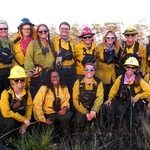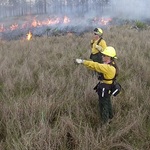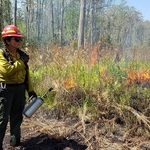
Controlled Burn Participants Pictured Above:
Back row (from left) Amanda Lindsay - University of Central Florida, Grace Howell - Alachua County Land Trust, Brooke Coulter - Bok Tower Gardens, Chelsea MacKenzie - TNC, Anne Reynolds - Florida Park Service Lake Kissimmee State Park, Jana Mott (Burn Boss) - TNC, Carrie Black - Palm Beach County, Ashley Orlando - Florida Park Service Dunn Creek State Park, Sarah Martin - TNC, Amy Pulley - Florida Forest Service.
Front Row (from left) Landon Simpson - The Student Conservation Association/TNC, Char’Rese Finney - TNC, Elysia Dytrych - Florida Fish and Wildlife Conservation Commission, Cody-Marie Miller - TNC, Katrina Noland - Bok Tower Gardens.
With broader diversity needed in wildland fire work, women are seizing the opportunity.
April 16, 2019 - nature.org
They've had morning introductions. They've heard the weather forecast. They've carefully reviewed plans and discussed safety issues. They've donned protective gear, checked radios and dispersed to vehicles to start the day's activity: a controlled burn on 250 acres of longleaf pine forest and grasslands at The Nature Conservancy's Disney Wilderness Preserve.
While controlled burns aren’t uncommon on this 11,500-acre preserve in central Florida, this crew is a first: an all-female team of 15 women from TNC and partner agencies.
The idea of conducting an all-female controlled burn was conceived by Cody-Marie Miller and Sarah Martin, both on TNC's land stewardship staff in Florida.
"We got to talking how cool it would be to be on a burn staffed by all women," Miller said. "We started out with a list of eight names and the support of our staff here in The Nature Conservancy. And when the conditions were right and the time finally came around, I put out the call for a crew and we ended up with 15 women from seven different partner agencies."
Both experienced in conducting controlled burns, Miller and Martin wanted the event to inspire other women, particularly younger ones, to enter a field that's long been dominated by men.

“I’m Not Out of Place Here.”
All staff and partners who take part in controlled burns like this must meet fitness, training and experiential standards established by U.S. federal and state land and fire management agencies. Each crew member is qualified to play certain roles on the fireline, as indicated by his or her current “red card.” Having common standards facilitates multi-agency burns, which are increasingly the norm.
Jana Mott was the day's burn boss, the person who's in charge of directing the operations, making sure the burn is conducted safely and effectively. Mott is TNC's northern Florida stewardship project coordinator.
"We're in this moment where women's presence in traditionally all-male roles is being recognized," Mott said. "And this is an opportunity to be a part of that moment and recognize that the number of women in this field is growing and try to be an inspiration to additional girls who might be interested in natural resources to look at this field and say, 'hey look, I'm not out of place here.'"
For the crew at Disney Wilderness Preserve, the controlled burn was much like any other, with few exceptions. Some knew each other, but others weren't well-acquainted. That didn't prove to be a hindrance though; by end of the day, their camaraderie was strong.
And like any controlled burn aimed at restoring and maintaining forests and grasslands, the crew worked hard and handled complex assignments. For any crew, the work is challenging, physically demanding and sometimes dangerous. They're using hand-tools, drip torches and hand-held firing devices. They're driving utility vehicles and engines. And of course, there's smoke and fire.
"Everybody was here to work, and communication went well," Mott said. "It was like a well-oiled machine. There was a high level of professionalism all around. It felt like just another day of doing business on the fireline."

Increasing Opportunities for Women on the Fireline
The all-female crew at Disney Wilderness Preserve is just one of many signs of a growing presence of women who are managing lands with fire and fighting wildfires.
The same week as the Disney Wilderness burn, 40 women and a few men gathered 250 miles away in Tallahassee, Florida, for an intensive, 12-day training session on controlled burning. This was the third Women-in-Fire Prescribed Fire Training Exchange (or WTREX), sponsored by TNC, U.S. Forest Service, National Park Service and others. Participants from four countries and 16 states burned more than 600 acres and learned skills in sessions geared toward women.
Among this year's WTREX participants was Maria Estrada, associate director of TNC's Diversity and Inclusion Program. For Estrada, the WTREX training was a chance to earn her wildland fire credentials, her "red card," allowing her to work in controlled burns.
"It felt really good to go through the training," Estrada said. "It gave me a very good understanding of fire and of the dynamics of leadership. And it was empowering to see a group of women who were passionate about their work. I could see the joy in their faces."
More than that, however, Estrada’s involvement was a chance to train the WTREX women in the concepts of active bystander and unconscious bias, which help participants recognize an incident as harassment, discrimination or homophobia and skillfully take action to engender change. Research shows that building these skills can make a difference in changing an organization’s climate so that people feel welcome to bring all that they have to offer without fear of being punished or shamed.
Diversity of Perspectives Helps Tackle Tough Problems
Training women in the practice of controlled burns is not just about empowerment, Estrada said. It's also about adding to the sorely needed workforce for restoring forests, grasslands and other lands that are naturally dependent on fire. For more than a century, fire has been discouraged from much of those lands across the U.S., drastically altering habitats and, in some cases, allowing the build-up of vegetation and dangerous levels of fuel for future fires.
"We're catching up after 100 years of fire suppression," Estrada said. "There's a lot of work to be done in restoring fire to these lands."
Opportunities like WTREX and the all-female controlled burn signal a new attitude that women and people from many walks of life need to play a role in restoring and maintaining fire-dependent lands, she said. "Wicked problems require a diversity of perspectives to tackle. We need more people of all backgrounds bringing good fire to the ground."
Lenya Quinn-Davidson of Eureka, California, helped plan and lead the WTREX in Tallahassee, as well as two previous WTREX. She works for the University of California Cooperative Extension and is director of the Northern California Prescribed Fire Council.
The field of wildland fire has for too long been “so conventional, so static—not only operationally, but also culturally,” Quinn Davidson said. “We see now that it’s time for that to change. We need more perspectives, more ideas, more innovation—more creative discomfort. And we need to create space for women and men of different backgrounds to have a voice and contribute to this evolution.”



